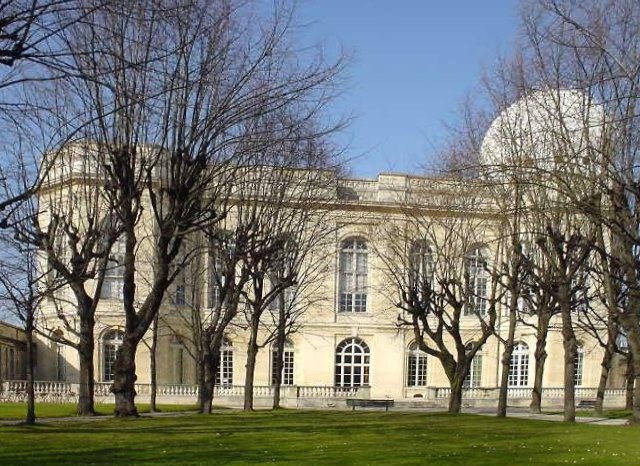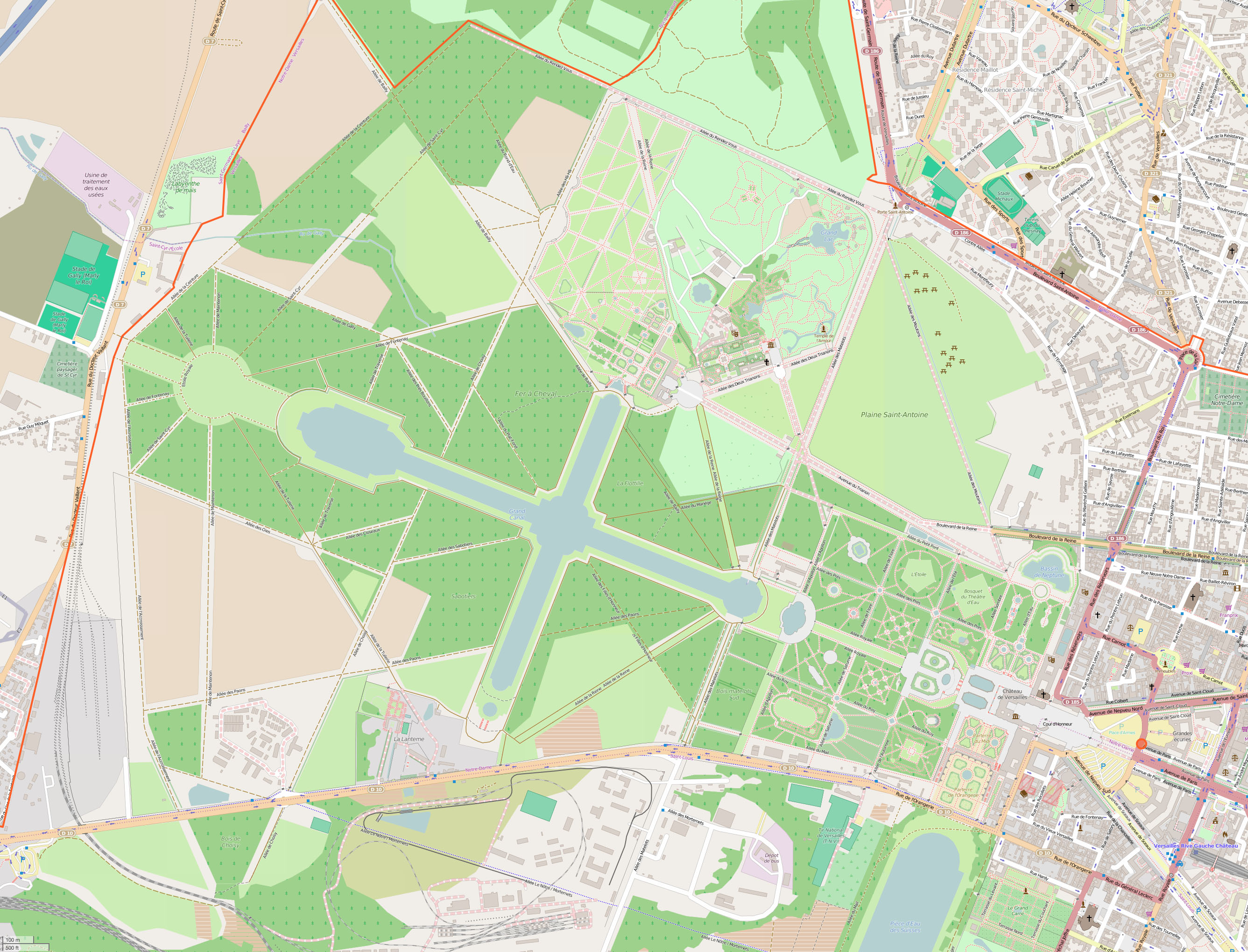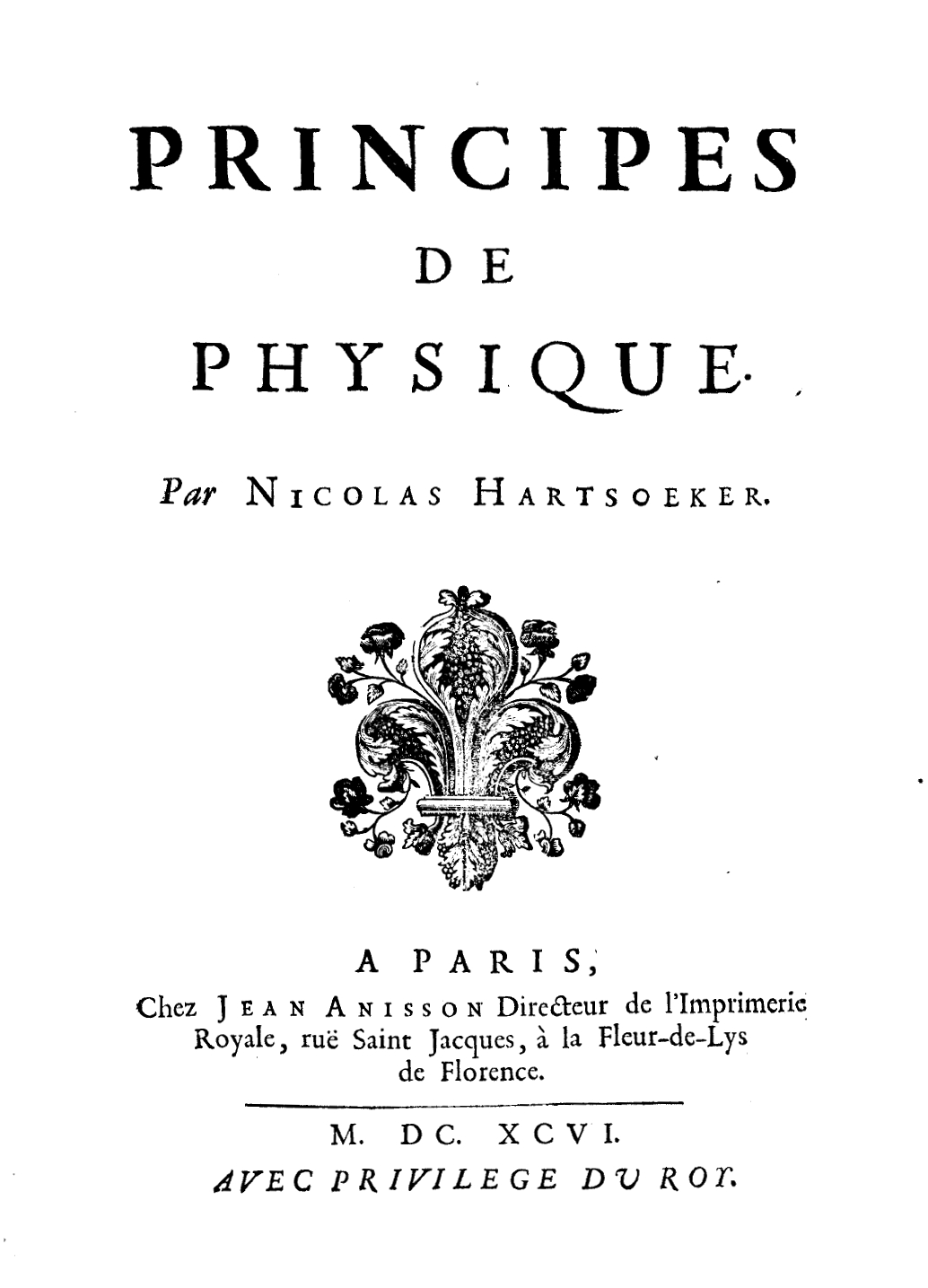|
Aerial Telescope
An aerial telescope is a type of very long focal length refracting telescope, built in the second half of the 17th century, that did not use a tube. Instead, the objective was mounted on a pole, tree, tower, building or other structure on a swivel ball-joint. The observer stood on the ground and held the eyepiece, which was connected to the objective by a string or connecting rod. By holding the string tight and maneuvering the eyepiece, the observer could aim the telescope at objects in the sky. The idea for this type of telescope may have originated in the late 17th century with the Dutch mathematician, astronomer and physicist Christiaan Huygens and his brother Constantijn Huygens, Jr., though it is not clear if they actually invented it. Invention and application Very long "tubed" telescopes Telescopes built in the 17th and early 18th century used single element non-achromatic objective lenses that suffered from interfering rainbow halos (chromatic aberration) introdu ... [...More Info...] [...Related Items...] OR: [Wikipedia] [Google] [Baidu] |
Huygens Aerial Telescope, 1684
Huygens (also Huijgens, Huigens, Huijgen/Huygen, or Huigen) is a Dutch patronymic surname, meaning "son of Hugo". Most references to "Huygens" are to the polymath Christiaan Huygens. Notable people with the surname include: * Jan Huygen (1563–1611), Dutch voyager and historian * Constantijn Huygens (1596–1687), Dutch poet, diplomat, scholar and composer * Constantijn Huygens, Jr. (1628–1697), Dutch statesman, soldier, and telescope maker, son of Constantijn Huygens * Christiaan Huygens (1629–1695), Dutch mathematician, physicist and astronomer, son of Constantijn Huygens * Lodewijck Huygens (1631–1699), Dutch diplomat, the third son of Constantijn Huygens * Cornélie Huygens (1848–1902), Dutch writer, social democrat and feminist * Léon Huygens (1876–1918), Belgian painter * Jan Huijgen (1888–1964), Dutch speedwalker * Christiaan Huijgens (1897–1963), Dutch long-distance runner * Wil Huygen (1922–2009), Dutch children's and fantasy writer, e.g. of Gnomes Na ... [...More Info...] [...Related Items...] OR: [Wikipedia] [Google] [Baidu] |
Optical Telescope
An optical telescope is a telescope that gathers and focuses light mainly from the visible part of the electromagnetic spectrum, to create a magnified image for direct visual inspection, to make a photograph, or to collect data through electronic image sensors. There are three primary types of optical telescope: * Refracting telescopes, which use lenses and less commonly also prisms ( dioptrics) * Reflecting telescopes, which use mirrors ( catoptrics) * Catadioptric telescopes, which combine lenses and mirrors An optical telescope's ability to resolve small details is directly related to the diameter (or aperture) of its objective (the primary lens or mirror that collects and focuses the light), and its light-gathering power is related to the area of the objective. The larger the objective, the more light the telescope collects and the finer detail it resolves. People use optical telescopes (including monoculars and binoculars) for outdoor activities such as obser ... [...More Info...] [...Related Items...] OR: [Wikipedia] [Google] [Baidu] |
Giuseppe Campani
Giuseppe Campani (1635–July 28, 1715) was an Italian optician and astronomer who lived in Rome during the latter half of the 17th century. Life Giuseppe Campani was born in 1635. He was an Umbrian from Castel San Felice near Spoleto. His lenses and telescopes, made in Rome, were sent as far as Florence and Paris. Campani was known as the best maker of optical instruments of his age. His brother, Matteo Campani-Alimenis, and he were experts in grinding and polishing lenses, especially for very long focal length aerial telescope objectives. His brother is also noted as a mechanician for his work on clocks. He was a priest in charge of a parish in Rome. Louis XIV of France ordered several long-focus lenses (86, 100, 136 feet respectively) for the astronomer Giovanni Domenico Cassini. With these Cassini found several moons of the planet Saturn, among other discoveries. Constantijn Huygens, Jr., brother of Christiaan Huygens, acquired one of Campani's telescopes. While in Londo ... [...More Info...] [...Related Items...] OR: [Wikipedia] [Google] [Baidu] |
Paris Observatory
The Paris Observatory (french: Observatoire de Paris ), a research institution of the Paris Sciences et Lettres University, is the foremost astronomical observatory of France, and one of the largest astronomical centers in the world. Its historic building is on the Left Bank of the Seine in central Paris, but most of the staff work on a satellite campus in Meudon, a suburb southwest of Paris. The Paris Observatory was founded in 1667. Construction was completed by the early 1670s and coincided with a major push for increased science, and the founding of the Royal Academy of Sciences. King Louis XIV's minister of finance organized a "scientific powerhouse" to increase understanding of astronomy, maritime navigation, and science in general. Through the centuries the Paris Observatory has continued in support of astronomical activities, and in the 21st century connects multiple sites and organizations, supporting astronomy and science, past and present. Constitution Adminis ... [...More Info...] [...Related Items...] OR: [Wikipedia] [Google] [Baidu] |
Gardens Of Versailles
The Gardens of Versailles (french: Jardins du château de Versailles ) occupy part of what was once the ''Domaine royal de Versailles'', the royal demesne of the château of Versailles. Situated to the west of the palace, the gardens cover some 800 hectares of land, much of which is landscaped in the classic French formal garden style perfected here by André Le Nôtre. Beyond the surrounding belt of woodland, the gardens are bordered by the urban areas of Versailles to the east and Le Chesnay to the north-east, by the National Arboretum de Chèvreloup to the north, the Versailles plain (a protected wildlife preserve) to the west, and by the Satory Forest to the south. Administered by the Public Establishment of the Palace, Museum and National Estate of Versailles, an autonomous public entity operating under the aegis of the French Ministry of Culture, the gardens are now one of the most visited public sites in France, receiving more than six million visitors a year. In ad ... [...More Info...] [...Related Items...] OR: [Wikipedia] [Google] [Baidu] |
Machine De Marly
The Machine de Marly, also known as the Marly Machine or the Machine of Marly, was a large hydraulic system in Yvelines, France, built in 1684 to pump water from the river Seine and deliver it to the Palace of Versailles.Thompson 2006, p. 251. King Louis XIV needed a large water supply for his fountains at Versailles. Before the Marly Machine was built, the amount of water delivered to Versailles already exceeded that used by the city of Paris, but this was insufficient, and fountain-rationing was necessary. Ironically most of the water pumped by the Marly Machine ended up being used to develop a new garden at the Château de Marly. However, even if all the water pumped at Marly (an average of per day) had been supplied to Versailles, it still would not have been enough: the fountains running ''à l'ordinaire'' (that is, at half pressure) required at least four times as much. The Machine de Marly, based on a prototype at the Château de Modave, consisted of fourteen giganti ... [...More Info...] [...Related Items...] OR: [Wikipedia] [Google] [Baidu] |
Giovanni Domenico Cassini
Giovanni Domenico Cassini, also known as Jean-Dominique Cassini (8 June 1625 – 14 September 1712) was an Italian (naturalised French) mathematician, astronomer and engineer. Cassini was born in Perinaldo, near Imperia, at that time in the County of Nice, part of the Savoyard state. Cassini is known for his work on astronomy and engineering. He discovered four satellites of the planet Saturn and noted the division of the rings of Saturn; the Cassini Division was named after him. Giovanni Domenico Cassini was also the first of his family to begin work on the project of creating a topographic map of France. The ''Cassini'' space probe, launched in 1997, was named after him and became the fourth to visit the planet Saturn and the first to orbit the planet. Life Time in Italy Cassini was the son of Jacopo Cassini, a Tuscan, and Giulia Crovesi. In 1648 Cassini accepted a position at the observatory at Panzano, near Bologna, to work with Marquis Cornelio Malvasia, a rich amate ... [...More Info...] [...Related Items...] OR: [Wikipedia] [Google] [Baidu] |
Paris Observatory XVIII Century
Paris () is the capital and most populous city of France, with an estimated population of 2,165,423 residents in 2019 in an area of more than 105 km² (41 sq mi), making it the 30th most densely populated city in the world in 2020. Since the 17th century, Paris has been one of the world's major centres of finance, diplomacy, commerce, fashion, gastronomy, and science. For its leading role in the arts and sciences, as well as its very early system of street lighting, in the 19th century it became known as "the City of Light". Like London, prior to the Second World War, it was also sometimes called the capital of the world. The City of Paris is the centre of the Île-de-France region, or Paris Region, with an estimated population of 12,262,544 in 2019, or about 19% of the population of France, making the region France's primate city. The Paris Region had a GDP of €739 billion ($743 billion) in 2019, which is the highest in Europe. According to the Economist Intellig ... [...More Info...] [...Related Items...] OR: [Wikipedia] [Google] [Baidu] |
A History Of The Human Love Affair With Reflection
A, or a, is the first letter and the first vowel letter of the Latin alphabet, used in the modern English alphabet, and others worldwide. Its name in English is '' a'' (pronounced ), plural ''aes''. It is similar in shape to the Ancient Greek letter alpha, from which it derives. The uppercase version consists of the two slanting sides of a triangle, crossed in the middle by a horizontal bar. The lowercase version is often written in one of two forms: the double-storey and single-storey . The latter is commonly used in handwriting and fonts based on it, especially fonts intended to be read by children, and is also found in italic type. In English, '' a'' is the indefinite article, with the alternative form ''an''. Name In English, the name of the letter is the ''long A'' sound, pronounced . Its name in most other languages matches the letter's pronunciation in open syllables. History The earliest known ancestor of A is ''aleph''—the first letter of the Phoenician ... [...More Info...] [...Related Items...] OR: [Wikipedia] [Google] [Baidu] |
Mark Pendergrast
Mark Pendergrast (born 1948) is an American independent scholar and author of fourteen books, including three children's books. His books are mainly non-fiction and cover a wide range of topics, most notably repressed memories. He is a volunteer with the National Center for Reason and Justice, a non-profit organization that advocates for people who are falsely accused or convicted of crimes. Early life and education Pendergrast was born in 1948 to Nan and Britt Pendergrast, the fourth of seven children. He was raised in Atlanta, Georgia. He earned a Bachelor of Arts degree in English Literature from Harvard College, after which he taught for several years in public schools. Pendergrast later attended Simmons College in Boston, where he obtained a Master of Arts degree in Library Science. He worked as an academic librarian and freelance writer until becoming a full-time writer in 1991. Pendergrast lives in Colchester, Vermont. As a child during road trips with his family, Pend ... [...More Info...] [...Related Items...] OR: [Wikipedia] [Google] [Baidu] |
Royal Society Of London
The Royal Society, formally The Royal Society of London for Improving Natural Knowledge, is a learned society and the United Kingdom's national academy of sciences. The society fulfils a number of roles: promoting science and its benefits, recognising excellence in science, supporting outstanding science, providing scientific advice for policy, education and public engagement and fostering international and global co-operation. Founded on 28 November 1660, it was granted a royal charter by Charles II of England, King Charles II as The Royal Society and is the oldest continuously existing scientific academy in the world. The society is governed by its Council, which is chaired by the Society's President, according to a set of statutes and standing orders. The members of Council and the President are elected from and by its Fellows, the basic members of the society, who are themselves elected by existing Fellows. , there are about 1,700 fellows, allowed to use the postnominal ti ... [...More Info...] [...Related Items...] OR: [Wikipedia] [Google] [Baidu] |
Nicolaas Hartsoeker
Nicolaas Hartsoeker (26 March 1656 – 10 December 1725) was a Dutch mathematician and physicist who invented the screw-barrel simple microscope . Biography He was the son of Anna van der Meij and Christiaan Hartsoeker (1626–1683), a Remonstrant minister in Moordrecht near Gouda. His father took the family to Alkmaar in 1661 and finally to Rotterdam in 1669. Nicolaas started to make a living as a lens maker in Rotterdam, and was instructed in optics by Antonie van Leeuwenhoek. In 1674, he and a fellow student, assisted by Van Leeuwenhoek, were the first to observe semen, a situation that would later lead to a priority dispute between Hartsoeker and Leeuwenhoek over the discovery of spermatozoids. In 1677, Hartsoeker met Christiaan Huygens and initiated him in the making of lenses. In June 1678, Hartsoeker accompanied, in the role of an assistant, Huygens on a trip to Paris, where they made a great impression with their microscopes. However, Huygens failed to mention Harts ... [...More Info...] [...Related Items...] OR: [Wikipedia] [Google] [Baidu] |







